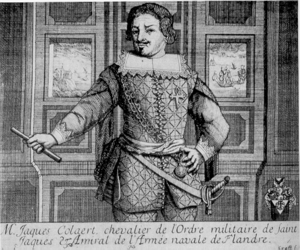Jacob Collaert facts for kids
Quick facts for kids
Jacob Collaart
|
|
|---|---|
 |
|
| Died | 1637 |
| Piratical career | |
| Nickname | Colaert of Duinkerken |
| Type | Dunkirker |
| Allegiance | Habsburg |
| Rank | Admiral |
| Base of operations | Dunkirk |
| Battles/wars | Eighty Years' War |
Jacob Collaart (active around 1625–1637) was a famous sea captain from Flanders. He worked as a privateer for the Spanish Habsburgs during the Dutch Revolt. Privateers were like government-approved sailors who captured enemy ships. Collaart was one of the well-known "Dunkirkers" who sailed from the port of Dunkirk.
He was very successful at sea. Collaart captured or destroyed at least 150 fishing boats. He also brought 945 captured sailors back to Dunkirk. These sailors were held for ransom, meaning their release was bought with money. He even had encounters with other famous Dutch sea captains.
Contents
Jacob Collaart: A Sea Adventurer
Jacob Collaart was a very important admiral for the Spanish. From 1633 to 1637, he was the Vice Admiral of the Royal Squadron. This group of ships operated out of Dunkirk.
Attacking Fishing Fleets
In 1635, Collaart's attacks caused big problems for the Dutch city of Flushing. His raids on their herring fishing boats cost the city over two million guilders. Guilders were a type of money used back then.
At the start of 1635, the Dutch navy was trying to block Dunkirk. This meant they tried to stop ships from leaving or entering the port. However, some Dutch warships left to help French forces. This made the blockade weaker.
On August 14, Collaart took advantage of this. He sailed out of Dunkirk with 21 ships. He successfully broke through the Dutch blockade.
Big Victories at Sea
Just three days later, Collaart's fleet found a large herring fishing fleet. It had 160 fishing boats. Only one warship, with 39 guns and 85 men, was guarding them. Collaart's ships easily defeated the escort.
They sank or set fire to 74 fishing boats. The remaining boats managed to escape.
On August 19, Collaart's forces struck again. They chased away six Dutch warships. Then, they destroyed about 50 more herring boats near Doggersbank.
Captives and Ransom
After these attacks, Collaart had many captives. He put 150 fishermen, including the wounded, young, and old, on a merchant ship. He sent them back to the Dutch Republic. The other 775 fishermen were kept as captives for ransom.
The Dutch Response
The Dutch government, called the States-General of the Netherlands, quickly reacted. They ordered all available ships to chase Collaart's fleet. A Dutch fleet sailed from Rotterdam. Its commander, Willem Codde van der Burch, was told to meet other admirals.
He was to meet Philips van Dorp and Vice Admiral Quast. Van Dorp was returning from La Rochelle.
Escaping the Dutch Fleet
Collaart soon met the combined Dutch fleet. It had 20 warships. Collaart's ships managed to damage four of them. But then, Quast's fleet arrived, making the fight too difficult. Collaart decided to leave the battle.
Thanks to bad weather, Collaart was able to escape back to Dunkirk. He arrived on September 8, 1635. He brought 975 captive fishermen with him.
Later Years and Legacy
The next year, in 1636, Collaart was sailing with two other privateers. Near Dieppe, they fought a five-hour battle against Captain Johan Evertsen. Collaart and Mathieu Romboutsen were captured. The third captain managed to escape to an English port.
Jacob Collaart died from an illness in A Coruña in August 1637. His son, Jacques Collaert the Younger, also became a privateer. Collaart was also the father-in-law of a later English Vice-Admiral, Edward Spragge.
See also
 In Spanish: Jacob Collaert para niños
In Spanish: Jacob Collaert para niños

